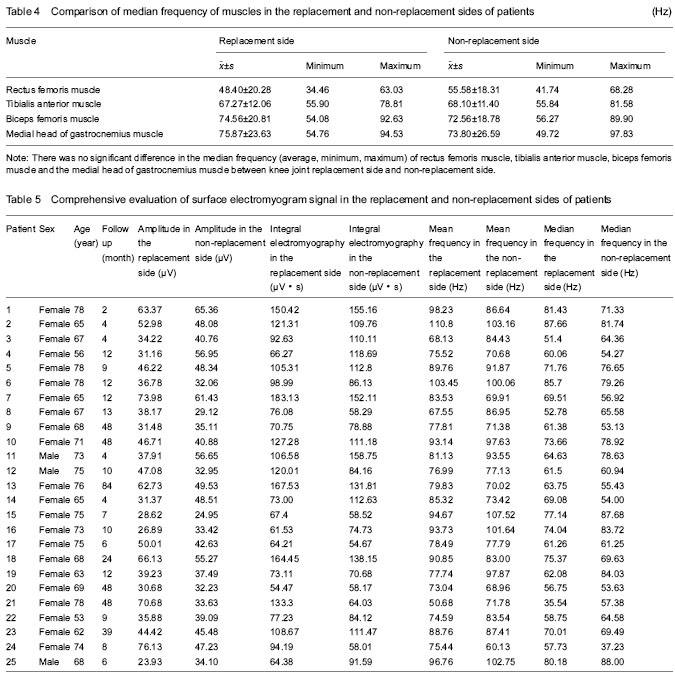| [1] Shen YQ, Liu FX, Cao H, et al. Clinical manifestation and influence factors in patients with knee osteoarthritis. Zhongguo Zuzhi Gongcheng Yanjiu yu Linchuang Kangfu. 2011;15(9):1643-1646.[2] Liu ZH, He C, Feng JM, et al. Three dimentional kinematics study of knee after unicompartmental arthroplasty. Zhonghua Guanjie Waike Zazhi: Dianziban. 2013;7(4): 438-442.[3] Liu J, Sun ZH, Tian ZW, et al. Clinical analysis of total knee arthroplasty by minimally invasive minisubvastus approach. Zhongguo Jiaoxing Waike Zazhi. 2008;16(9):649-652.[4] Li F, Xu YM, Shen LY, et al. Isometric Contraction Can Alleviate Arthrogenous Muscle Inhibition. Zhongguo Yundong Yixue Zazhi. 2000;19(2):131-132.[5] Yuan SJ, Liang Y, Xue YP, et al. Therapeutic effects of sensorimotor training on patients with knee osteoarthritis. Zhonghua Wuli Yixue yu Kangfu Zazhi. 2011;33(4): 290-293.[6] Slemenda C, Brandt KD, Heilman DK, et al. Quadriceps weakness and osteoarthritis of the knee. Ann Intern Med. 1997;127(2):97-104.[7] Pang J, Cao YL, Shi YY, et al. Control study for muscle force and component of body of female patients with knee osteoarthritis. Zhongguo Gushang. 2008;2l(11):828-830.[8] Shi DL, Wang NH, Xie B. Activation Characteristics of Vastus Medialis, Rectus Femoris and Vastus Lateralis Muscles in Patients with Knee Osteoarthritis and Health Subjects. Zhongguo Kangfu Lilun yu Shijian. 2009;15(6): 508-513.[9] Shi DL, Wang NH, Xie B. Coordination of Vastus Medialis, Rectus Femoris and Vastus Lateralis in Patients with Knee Osteoarthritis. Zhongguo Kangfu Lilun yu Shijian. 2010; 16(5):473-477.[10] Yu XJ, Wu Y, Hu YS, et al. Surface electromyography of patients with knee osteoarthritis. Zhonghua Wuli Yixue yu Kangfu Zazhi. 2006;28(6):402-405.[11] Guo YM, Wang QH, Zhu CX, et al. Correlation between Lower Extremity Extensor Muscle Strength and Pain or Physical Function in Knee Osteoarthritis. Zhongguo Kangfu Lilun yu Shijian. 2010;16(1):25-26.[12] Maehner A, Pap G, Awiszus F. Evaluation of quadriceps strength and voluntary activation after unicompartmental arthroplasty for medial osteoarthritis of the knee. J Orthop Res. 2002;20(1):108-111.[13] Li F, Fan ZH, Tu DY, et al. Muscle weakness of knee osteoarthritis: the exercise effects may be selective. Zhongguo Linchuang Kangfu. 2003;7(17): 2470-2471.[14] Wu WX, Xu WH, Liu WQ, et al. Effect of early proprioception training on the walking ability of patients after total knee arthroplasty. Zhongguo Jiaoxing Waike Zazhi. 2013;21(15):1508-1512.[15] Zhang J, Guo KB, Xiong YB. Total knee arthroplasty for knee arthritis in 126 middle-aged and elderly patients. Zhongguo Zuzhi Gongcheng Yanjiu yu Linchuang Kangfu. 2010;14(35):6612-6615.[16] Yue CL, Wang GX, Wang WJ. Characteristics of surface electromyography and peak torque of knee extension and flexion in athletes with patellar tendinopathy. Zhongguo Zuzhi Gongcheng Yanjiu. 2012;16(2):303-306.[17] Reilly O, Jones A, Muir KR, et al. Quadriceps weakness in knee osteoarthritis: the effect on pain and disability. Ann Rheum Dis.1998;57:588-594.[18] Maffiuletti N, Bizzini M, Widler K, et al. Asymmetry in quadriceps rate of force development as a functional outcome measure in TKA. Clin Orthop Relat Res. 2010;468: 191-198.[19] Wu L, Li Y, Yao JF. Study of rehabilitation program on the isokinetic muscle strength test of patients with knee osteoarthritis after total knee arthroplasty. Shanxi Yixue Zazhi. 2012;41(11):1507-1509.[20] Wang NH, Yan JT, Sun WQ, et al. Effects of early application of Tuina treatment on quadriceps surface myoelectricity in patients after total knee arthroplasty: a randomized controlled trial. Zhongxiyi Jiehe Xuebao. 2012;10(11):1247-1253.[21] Bai YH, Zhou J, Liang J. Changes in the gait analysis associated parameters of healthy people and patients with joint disease. Zhongguo Zuzhi Gongcheng Yanjiu Yu Linchuang Kangfu. 2007;11(9):1790-1793.[22] Huang P, Qi J, Deng LF, et al. Surface electromyography analysis of the lower limb muscles of normal young people during natural gait. Zhongguo Zuzhi Gongcheng Yanjiu. 2012;16(20):3680-3684. |



